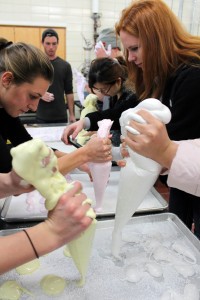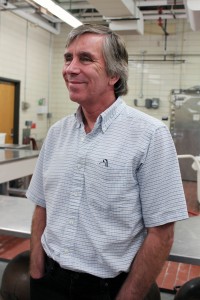A UW-Madison lab celebrates 50 years of crazy concoctions and tasty treats
By: Jade Likely

Photo by: Stephanie Wezelman
UW-Madison Food Engineering Professor Rich Hartel’s office is lined with bags and boxes of chocolates. His computer screensaver alternates between pictures of different brands of candy, and his bookshelves are lined with publications on ice creams and confectioneries. Indeed, he may have the sweetest office in Madison.
That’s because he is the university’s resident sugar expert and the coordinator of UW-Madison’s Resident Course in Confectionery Science, or simply Candy School, as it is often called. Each summer, the food science department hosts a two-week professional course on candy making, aimed at helping representatives from companies nationwide learn the ins and outs of candy technology. While many Wisconsinites may not be aware of the Candy School, bigwigs like Mars, Wrigley and Ferrero have taken note.
Decades of Sweet Success
Candy School celebrated its 50th anniversary this summer, marking five decades of savory success in the confectionery world. Hartel, who took over as Candy School coordinator in 1998 after founder and professor Joe von Elbe retired, organizes the two-week program. It includes guest lectures from candy experts and hands-on learning experiences for everyone, from new hires in the industry to CEOs of candy companies. The class is annually capped at about 27 students and attracts attendees from not just the United States, but also all around the world, including Pakistan, Japan and Mexico.
First offered in 1963 with full support from the National Confectioners Association, UW-Madison’s Candy School has gained a reputation in the confectionery industry as one of the only all-encompassing candy courses in the world.
“We’re the only one that teaches across the board, all sorts of different candies in such depth,” says Liz Thomas, a first-year master’s degree student working with Hartel to organize this year’s Candy School. The class also offers insight to those in the industry who may not know how easily they could create new products for their brand.
“Someone who’s making a hard candy could switch over and make a gummy relatively easy. There are really easy and fun and interesting ways to add value to your products without much additional effort or investment,” Thomas says.
Industry Interest and Support
Although the NCA has since ceased their complete monetary support for the program, Candy School is viewed as such an integral part of the candy universe that other major confectionery associations joined together to continue support for the course. These organizations also created an advisory board for the course to aid Hartel with continuation and upkeep.
“If I say I need a new gum mixer, they’ll find one or help find one. If I say I need a new instructor for hard candy, they’ll help identify names,” Hartel says.
Candy School is so well-known, in fact, that the small numbers of spots in the class are eaten up quite fast with little marketing on UW-Madison’s side. Each January, the class organizers simply send out a brochure to circulate through major candy associations and watch the spots fill up months before the class begins.
The class attracts people from all aspects of the candy world. Some come to learn about one type of candy specifically, while others are interested in getting a general overview of the candy-making process. Hartel explains that many times, companies that are going through major hiring processes send groups of students to Candy School as a crash course in candy technology.
“I get excited to see people come in. It’s like these students, their eyes light up when they see this made,” he says. “It’s different when you’re teaching people in the industry with a particular reason to learn.”
Expert Confections

Photo by: Stephanie Wezelman
Hartel has been working with the class for 27 years and began acting as coordinator when von Elbe retired. But von Elbe hasn’t been able to stay away from the Candy School.
According to Hartel, he has come out of retirement every time the summer class has been offered since his official departure.
It’s really no wonder von Elbe can’t stay away—Candy School brings in some of the greatest minds in the confectionery world to share their expertise with students in the course.
“I’m not an expert gum maker, so we go down to Wrigley and get an expert gum maker to come in and talk about gum,” notes Hartel. The course brings in two or three experts for each of the different sections, which range from gum making and hard candies, to chocolates and fondants, to taffies and gummies.
“They have real industry experience in each of their specific areas of focus, so you have an expert on hand to ask questions who has tried everything and who has probably failed a bunch of stuff and then made it suc cessful,” Thomas says.
Each class spends two mouthwatering days on each of the candies. Beginning with a presentation on the history and background of the product, the course then delves into the product’s basic ingredients and how to create it. Day two is truly delicious when students get to conduct manufacturing labs and concoct the confections they learned the day before.
Barb Klubertanz, a quality assurance manager at Impact Confections in Janesville, has been teaching the taffy and nougat section of the course for four years and says that the general knowledge of candy making is not the only benefit of the course.
“The class gives you contact and sources of information from many different areas that you have questions in,” she says. “It’s good networking.”
Not only do the students of Candy School get the opportunity to create professional relationships in the industry, they are also able to take back two detailed binders to their companies, documenting lessons from the class.
